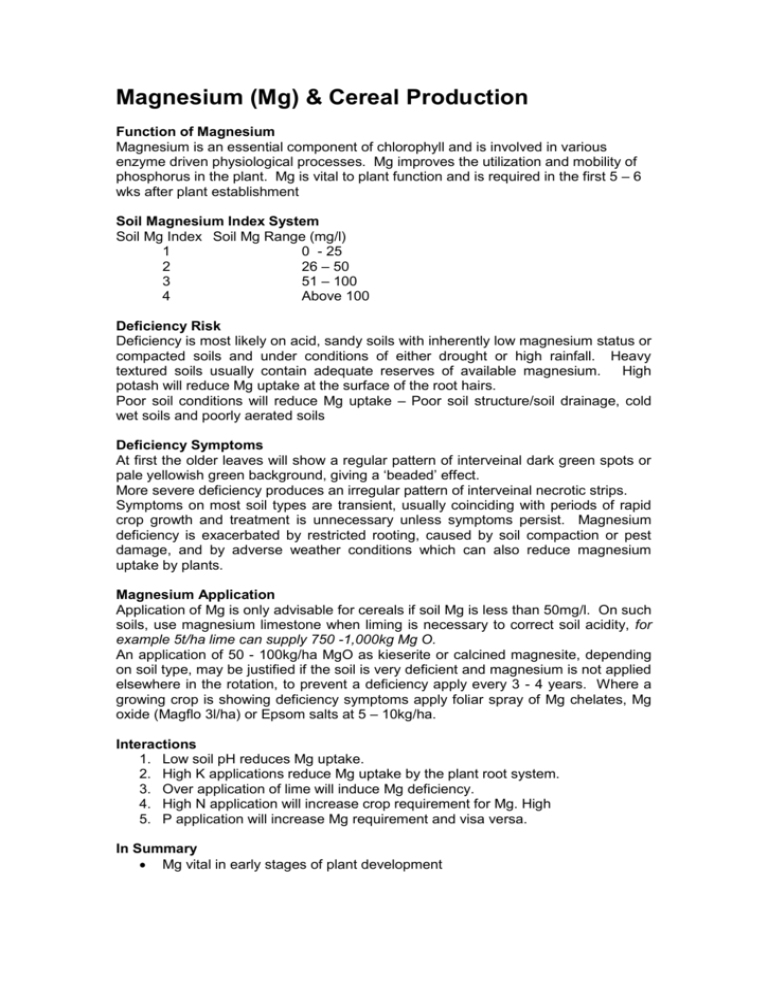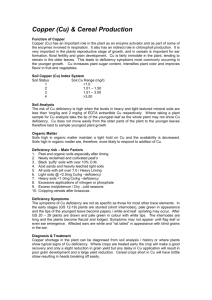Magnesium
advertisement

Magnesium (Mg) & Cereal Production Function of Magnesium Magnesium is an essential component of chlorophyll and is involved in various enzyme driven physiological processes. Mg improves the utilization and mobility of phosphorus in the plant. Mg is vital to plant function and is required in the first 5 – 6 wks after plant establishment Soil Magnesium Index System Soil Mg Index Soil Mg Range (mg/l) 1 0 - 25 2 26 – 50 3 51 – 100 4 Above 100 Deficiency Risk Deficiency is most likely on acid, sandy soils with inherently low magnesium status or compacted soils and under conditions of either drought or high rainfall. Heavy textured soils usually contain adequate reserves of available magnesium. High potash will reduce Mg uptake at the surface of the root hairs. Poor soil conditions will reduce Mg uptake – Poor soil structure/soil drainage, cold wet soils and poorly aerated soils Deficiency Symptoms At first the older leaves will show a regular pattern of interveinal dark green spots or pale yellowish green background, giving a ‘beaded’ effect. More severe deficiency produces an irregular pattern of interveinal necrotic strips. Symptoms on most soil types are transient, usually coinciding with periods of rapid crop growth and treatment is unnecessary unless symptoms persist. Magnesium deficiency is exacerbated by restricted rooting, caused by soil compaction or pest damage, and by adverse weather conditions which can also reduce magnesium uptake by plants. Magnesium Application Application of Mg is only advisable for cereals if soil Mg is less than 50mg/l. On such soils, use magnesium limestone when liming is necessary to correct soil acidity, for example 5t/ha lime can supply 750 -1,000kg Mg O. An application of 50 - 100kg/ha MgO as kieserite or calcined magnesite, depending on soil type, may be justified if the soil is very deficient and magnesium is not applied elsewhere in the rotation, to prevent a deficiency apply every 3 - 4 years. Where a growing crop is showing deficiency symptoms apply foliar spray of Mg chelates, Mg oxide (Magflo 3l/ha) or Epsom salts at 5 – 10kg/ha. Interactions 1. Low soil pH reduces Mg uptake. 2. High K applications reduce Mg uptake by the plant root system. 3. Over application of lime will induce Mg deficiency. 4. High N application will increase crop requirement for Mg. High 5. P application will increase Mg requirement and visa versa. In Summary Mg vital in early stages of plant development Seedbed dressing of Mg are only required if the soil is very deficient or if this nutrient is not applied elsewhere in the rotation which includes root crops that are susceptible to Mg deficiency Transient deficiency symptoms may appear during periods of rapid growth or when root development or weather conditions temporarily limit Mg uptake. High applications of K will induce Mg deficiency. Foliar spraying is not usually worthwhile unless symptoms persist.









